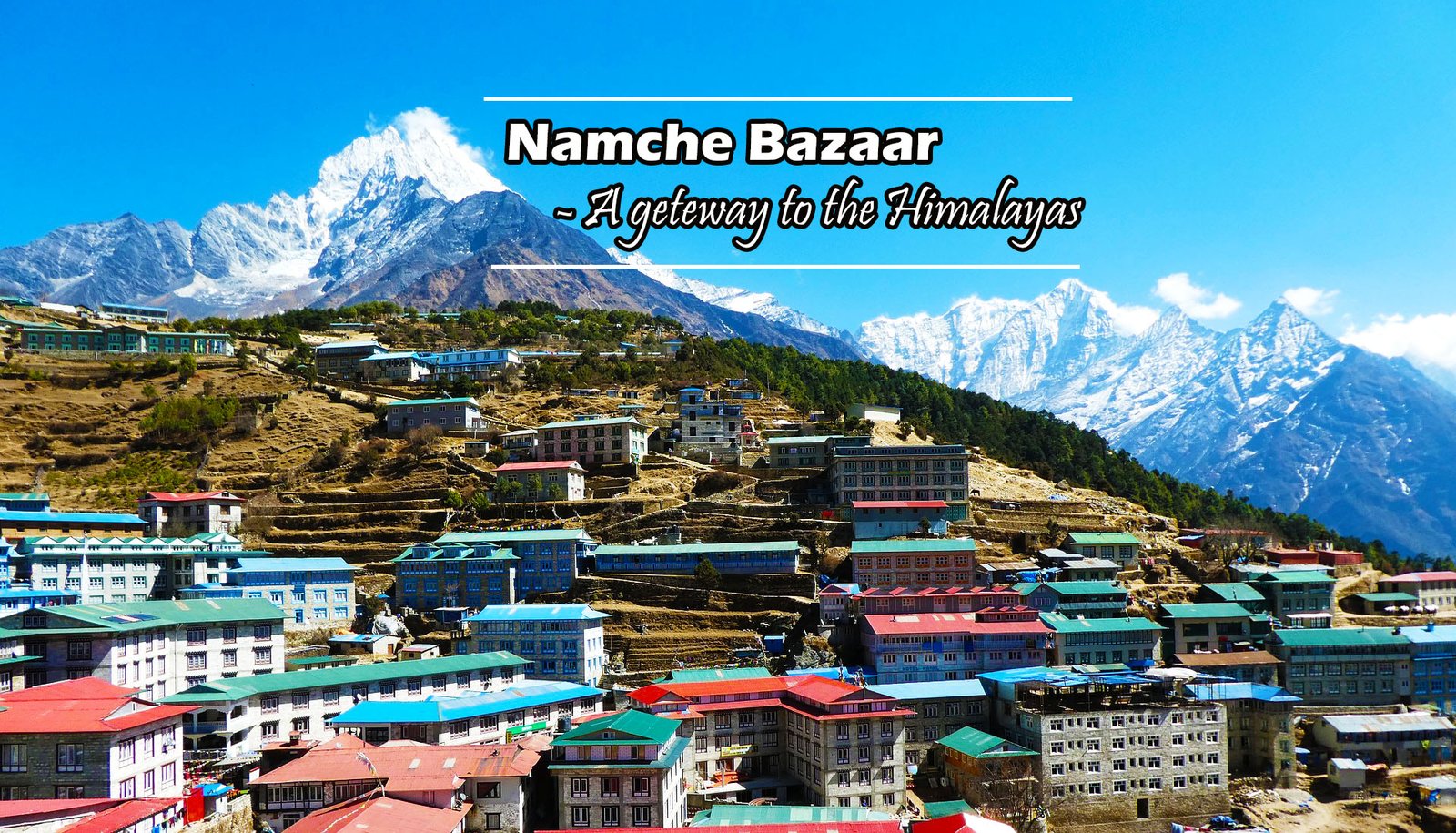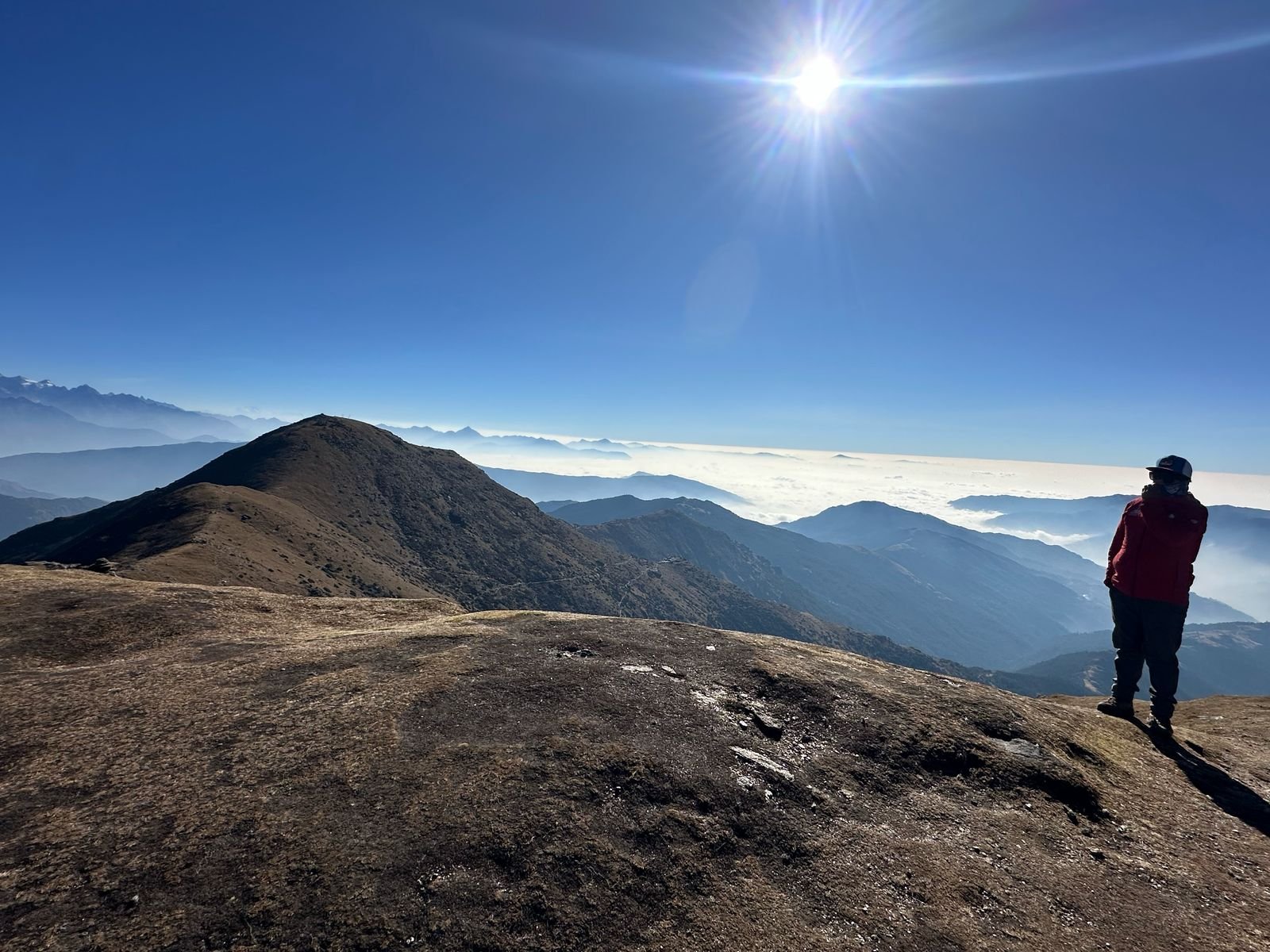Namche Bazaar, A gateway to the Himalayas

Namche Bazar overview
Namche Bazaar is a famous mountain town in the Solukhumbu district of northeastern Nepal. This bustling city in the heart of the Himalayas holds a special place in the hearts of trekkers and adventurers. Unique attractions, stunning scenery, and rich history make it a must-visit destination in Nepal.
Located at 3,440 meters (11,286 feet), this beautiful settlement is also known as the Sherpa capital. Namche is surrounded by high peaks, including Kongde Ri (6,187 m), Thamserku (6,623 m), and Khumbila (5,761 m). Located within the Sagarmatha National Park, the city is the main gateway to the Everest region.
The Dudhkoshi River flows through the valley below, adding to the city’s picturesque surroundings. Namche Bazaar is known for its vibrant atmosphere, colourful markets, and friendly locals. The city’s unique blend of tradition and modernity creates a truly unforgettable experience for visitors. It is a historic trading centre famous for its homemade yak cheese and butter.
This tourist centre is the most popular resting place in the Khumbu region. Now the main gateway to Everest, Namche Bazaar has become a busy tourist hub. Along with hotels and lodges, Namche has three small museums, a stupa, a monastery, several bakeries (cafés), and many fine stores. Mountaineers and trekkers can do last-minute shopping for essentials. Modern communication facilities allow hikers to stay in touch with the outside world.
Namche Bazaar, a major tourist centre in the Khumbu region, was once a historic trading centre. Tibetan and Nepalese traders used to buy and sell goods to each other. Even now, a market fair is held every Saturday, where the locals of the surrounding villages come to buy and sell goods.
Namche Bazaar is an important acclimatization point for high-altitude treks in the Everest region. Many trekkers acclimatize here for at least two nights before heading to the higher altitudes of the Everest region. Spending a few days in Namche reduces the risk of high-altitude sickness.
History of Namche Bazaar
Namche Bazaar is a testament to the Sherpa people’s enduring spirit and rich cultural heritage. The history of this bustling mountain town stretches back centuries. It started as a humble trading post and has grown to become the vibrant heart of the Everest region. Historically, the city was an important trading centre where Tibetan traders traded salt, wool, and other goods. As trade flourished in the region, the market crowded with Sherpa, Tibetan, and Nepali traders.
Over time, the indigenous Sherpas emerged as the dominant inhabitants of the region. The history of Namche Bazaar is closely linked with the history of mountaineering in the Everest region. Namche began to flourish when Western explorers set their sights on conquering the world’s highest peaks. Sir Edmund Hillary and Tenzing Norgay were the first climbers to reach the summit of Mount Everest in 1953 via Namche.
The Namche Bazaar has significantly changed with tourism growth in the Everest region in recent decades. Namche emerged as an important gateway for trekkers and mountaineers to experience the beauty of the Khumbu region. Over the past few decades, the town has developed rapidly, establishing guesthouses, restaurants, and shops.
How to reach Namche Bazaar?
Reaching the Namche amid majestic mountains is an adventure in itself. There are many options to reach this vibrant, bustling mountain town. Due to its remote location and rugged terrain, each option offers unique experiences and breathtaking views. Some possibilities to reach Namche Bazaar:
By Flight:
Travelers can reach Namche by flying from Kathmandu to Lukla Airport. A flight to Lukla Airport (Tenzing-Hilary Airport) is the most popular and convenient option. Lukla Airport is located at an altitude of approximately 2,845 meters (9,334 feet).
It takes about 30–40 minutes to reach Lukla Airport from Kathmandu, offering stunning aerial views of the Himalayas. After landing at Lukla airport, start the trek, which usually takes 2-3 days to reach Namche Bazaar. The route follows the Dudhkoshi River, passing through picturesque Sherpa villages, lush forests, and suspension bridges.
By land and flight combination:
Alternatively, you can opt for a scenic drive from Kathmandu to Phaplu or Saleri. It takes around 10–12 hours to drive from Kathmandu to Phaplu or Salleri. After reaching Phaplu or Salleri, visitors can trek to Namche Bazar via the classic Everest Base Camp trekking route. It takes 6–8 days to reach Namche, depending on walking speed. This extended approach offers a more off-the-beaten-path experience, passing charming villages and remote valleys.
Overland Trek from Jiri:
Another option is to start the trek from Jiri and reach Namche. Those looking for a more challenging and adventurous approach can opt for the overland route from Jiri to Namche Bazar. It is the classic route for Everest base camp trekking, which starts from Jiri and ends at Lukla. It takes 7 to 9 hours to reach Jiri, about 190 km (118 mi) northeast of Kathmandu. From Jiri, the route leads through rural landscapes, dense forests, and rugged terrain. It takes 7 to 10 days to reach Namche, depending on your walking speed.
Administrative center and economic hub

Namche Bazaar is the historical capital, administrative centre, and economic hub of the Khumbu region. Namche Bazaar plays an important dual role as both an administrative centre and an economic hub. It is a lifeline for local communities and a gateway for adventurers drawn to the world’s highest peaks.
Namche covers various government offices and agencies responsible for administration, conservation, and community development. Namche Bazar serves as the administrative headquarters for Sagarmatha National Park. The Sagarmatha National Park Administrative Office oversees the preservation and management of the national park.
The city hosts administrative offices for local municipalities. It plays a vital role in providing essential services and infrastructural development to residents and visitors alike. The Namche Bazaar includes educational institutions and hospitals that provide necessary services to local communities.
A lively market attracts merchants and traders from neighbouring villages. Namche also serves as a focal point for the tourism industry. Many lodges, teahouses, and shops cater to the needs of trekkers and mountaineers visiting the Everest region. Many banks and financial institutions offer banking services, currency exchange facilities, and ATM services.
first acclimatization spot
Namche is the first acclimatization point for trekkers and climbers embarking on high-altitude journeys in the Everest region. Acclimatization is paramount during high-altitude trekking in the Himalayas. Namche Bazar is located at an altitude of 3,440 meters, which makes it much higher than the usual habitat. Above 3,500 meters, the body needs more time to adjust as oxygen levels decrease.
Trekking without giving the body enough time to acclimatize increases the risk of altitude sickness. Symptoms such as headache, fatigue, nausea, and dizziness appear when high altitude sickness occurs. Acclimatization helps the body adjust to the thin air at high altitudes.
Therefore, an extra-day stay at Namche is necessary when trekking at high altitudes in the Everest region. Time spent at Namche allows gradual adjustment to reduced oxygen levels at higher altitudes. Acclimatization is the most effective way to reduce the risk of altitude sickness. Trekking at high altitudes becomes easier when well acclimated to low altitudes.
Exploring Sherpa Culture and Tradition
Namche Bazaar is known as the unofficial capital of the Khumbu region, serving as the centre of Sherpa culture. This bustling city offers visitors a fascinating glimpse into the unique way of life that has flourished for centuries. Sherpas are world-famous for their mountaineering skills.
One of the hallmarks of Sherpa culture is their legendary hospitality. They welcome visitors to the Namche Bazaar with warm smiles and open arms, giving a glimpse of the Sherpa lifestyle. Religion is important in Sherpa culture, with Tibetan Buddhism being the dominant faith.
The Sherpas are also steadfast in their commitment to preserving their cultural identity. They enthusiastically celebrate traditional ceremonies and festivals like Losar (Tibetan New Year) and Dumji. Buddhist monasteries and stupas at Namche serve as spiritual sanctuaries amid the highlands.
You can find prayer flags fluttering in the mountain breeze throughout Namche Bazaar. Intricately carved gemstones adorned with sacred mantras line the paths. Sherpa craftsmanship is renowned for its intricacy and beauty. Local artisans skillfully carve wooden statues and prayer wheels. They weave colourful fabrics and create Thangka paintings that testify to centuries-old techniques.
Facilities in Namche Bazaar
Hotel and restaurant
Namche Bazaar offers impressive amenities and facilities for travellers exploring the Everest region. Namche provides various accommodation options to suit every traveller’s needs and budget. Visitors can find options ranging from cozy teahouses and guesthouses to more upscale lodges and hotels. For dining, there are plenty of restaurants, cafes, and bakery shops. Visitors can enjoy everything from traditional Sherpa cuisine to Western cuisine.
Shops
Despite its remote location, Namche Bazaar boasts a lively market. Here, visitors can shop for essentials, souvenirs, and trekking gear. Local shops sell various goods, including warm clothing, handicrafts, hiking equipment, and jewellery. Namche Bazaar is also a convenient stop for those looking for unique souvenirs to take home.
Medical
Health facilities in Namche Bazaar cater to the needs of travellers and locals. The clinic provides primary medical care and treatment for common ailments and injuries. In addition, essential medicines are available in pharmacies. For more serious medical emergencies, helicopter evacuation services are also available to take patients to Kathmandu.
Internet
Namche Bazaar offers limited but reliable communication and connectivity options for travellers. Internet cafes provide access to the World Wide Web. Many hotels, guesthouses, and restaurants in Namche Bazaar offer Wi-Fi access. But connection speeds can be limited, especially during peak tourist seasons when bandwidth is in high demand.
Mobile data coverage is also available through local telecommunications providers. Mobile data services can be accessed with a local SIM card and a compatible mobile device. Additionally, satellite phones are available for rent. Satellite phones provide a reliable communication option in areas without mobile network coverage.
Banks and ATMs
Many banks and currency exchange facilities are available to provide essential financial services in Namche. ATMs allow withdrawal of Nepali currency using major international debit and credit cards. Currency exchange counters offer competitive rates for exchanging foreign currency. With access to banks, ATMs, and currency exchange services, travellers can manage their finances conveniently and securely in Namche.
Hotel and accommodations in Namche bazaar
Namche Bazaar provides essential food and comfortable accommodation for trekkers and mountaineers. Travelers can find a wide range of food and accommodation options. Trekkers can savour authentic Sherpa and Tibetan delicacies, including Dal Bhat (rice and lentil curry), Momos (dumplings), and Thukpa (rice soup). Italian pasta, pizza, and various other international dishes are also available. There are also bakeries and cafes where trekkers can enjoy freshly baked bread, pastries, cakes, and aromatic coffee.
Teahouses and guesthouses are the most common options in Namche for accommodation. These teahouses and guesthouses provide simple yet comfortable accommodations for visitors. They usually offer basic amenities such as clean rooms, communal bathrooms, and meals in communal dining areas. Visitors can enjoy cozy evenings by the fireplace and exchange stories with fellow hikers.
Namche Bazaar also offers lodges and inns with upgraded facilities for more comfort and convenience. They offer private rooms with en suite bathrooms, hot showers, and heating facilities. Some lodges may offer additional services such as Wi-Fi access, laundry facilities, and on-site restaurants.
Over the past few years, boutique hotels have also emerged in Namche Bazaar. These hotels cater to travellers looking for a more upscale lodging experience. In these hotels, travellers can enjoy modern amenities such as flat-screen TVs, minibars, and luxurious beds. Guests can enjoy personalized service and focus on detail amidst breathtaking mountain scenery. Namche also has an Irish pub where visitors can relax, enjoy a drink, and mingle with fellow hikers.
Permits for Namche visit
Namche is in the Everest region, and travellers must obtain permits to enter this region. Before reaching Namche, the Everest National Park entrance gate is where you can get the necessary permits. Permits required to visit Namche are:
Sagarmatha National Park Entry Permit:
Travellers can get this permit at the entrance of Sagarmatha National Park. It is also available from the office of the Nepal Tourism Board in Kathmandu for convenience. An Everest National Park entry permit costs approximately $30, including 13% VAT.
Khumbu Pasang Lhamu Rural Municipality Entry Permit:
It is another permit that travellers need to enter Namche. This permit can be obtained from the Khumbu Pasang Lhamu Rural Municipality office in Lukla. The fee for this permit is USD 20 per person. As this permit is unavailable in Kathmandu, it must be obtained in Lukla.
best time to visit Namche Bazaar

The seasons to visit Namche Bazaar are spring and autumn. Spring includes the months of March to May, during which the weather is generally stable. This time, it has clear skies with mild temperatures, which makes it ideal for visiting Namche Bazaar. Namche Bazaar also looks picturesque during this time due to blooming rhododendrons.
Autumn includes the months of September to November. The weather is generally dry and clear during this season as well. The skies are usually clear, with minimal rainfall, offering excellent visibility of the majestic Himalayan peaks. Autumn in the Everest region is characterized by mild temperatures, which makes the trip more enjoyable. The days are warm, while the nights are cool but not overly cold.
Read also: How much does the Everest base camp trek cost?
Things to do in Namche Bazaar
Namche Bazaar is one of the most important stops for trekkers and mountaineers on their way to various destinations in the Everest region. But it’s not just a place to stay for hikers; it is also a vibrant cultural centre and gateway to the majestic high Himalayas. There are many things travellers can do during their stay in Namche. Here is a detailed exploration of the things travellers can do at Namche Bazaar:
Explore the local market.
Exploring the Namche local market is integral to experiencing this Himalayan city’s vibrant culture and commerce. One of the best ways to explore Namche is to wander around the bustling local market. The market offers fresh produce, handmade handicrafts, and traditional artifacts. The main market square is a great place to visit and soak up the local atmosphere. Soaking in the market’s vibrant atmosphere will leave a lasting impression on the trip.
Visit the Sherpa Museum.
The Sherpa Museum at Namche Bazaar stands as a testament to the rich cultural heritage and mountaineering history of the Sherpas. This museum offers a deep insight into Sherpa culture, traditions, and legendary mountaineering expeditions. The museum displays a fascinating array of religious and cultural artifacts. One of the museum’s main attractions is the extensive collection of the history of Sherpa’s involvement in Himalayan expeditions. Visitors can learn about famous Sherpa climbers such as Tenzing Norgay.
Enjoy local cuisine
The local cuisine of Namche reflects the unique cultural heritage and culinary traditions of the Sherpa tribe. There are many authentic Sherpa dishes that visitors should try to experience the local flavor. Visitors can enjoy local delicacies such as Sherpa stew (Thukpa), yak meat dish, dal bhat, Tibetan roti (roti), and Sherpa pancake (Khapse). Enjoying local cuisine is also a cultural experience that provides an insight into the Sherpa’s traditions, tastes, and hospitality.
Explore monasteries and stupas.
Namche has many monasteries and stupas that offer visitors spiritual solace and cultural insight. Visitors can explore the small Namche Monastery, located amidst the city’s bustling streets. The monastery gives glimpses of daily religious practices and serves as a spiritual center for residents. Similarly, visitors can come across various stupas in Namche Bazaar and its surrounding areas. These Buddhist structures symbolize enlightenment and spiritual awakening. They serve as focal points for meditation and reflection, offering peaceful relaxation.
Enjoy scenic view
Namche Bazaar offers attractive scenic views that fascinate visitors with their beauty and magnificence. This mountain town offers stunning views of snow-capped peaks, green valleys, and lush landscapes. The towering snow-capped peaks form a majestic backdrop to the city, creating a dramatic and awe-inspiring vista. Visitors can also enjoy views of the Dudh Koshi River valley, terraced fields, dense forests, and traditional Sherpa villages.
Take a day trip to Khunde and Khumjung.
Visitors can take a day trip near Khunde and Khumjung from Namche Bazaar. This one-day trip offers an opportunity to explore Sherpa villages, experience local culture, and enjoy the mountain scenery. In Khunde village, there is Khunde Hospital, established in 1966 by Sir Edmund Hillary. The hospital provides healthcare to the local Sherpa community and is an important regional institution.
Khumjung Village has a famous Khumjung Monastery adorned with intricate Buddhist artwork and sculptures. From the vantage point of this serene monastery, visitors can enjoy panoramic views of the surrounding mountains. Khumjung also has the Hillary School, which Sir Edmund Hillary established to educate the area’s children. Visitors can learn about the school’s mission and interact with students and teachers.
Visit the Saturday market.
Namche Bazaar hosts a lively and bustling weekly market every Saturday. The market is a focal point for the local community and a highlight for visitors trekking in the Everest region. The market offers a variety of goods, such as fresh produce, daily essentials, souvenirs, etc. It attracts traders from surrounding areas to sell goods like soap, butter, vegetables, and other local products. By participating in the market, visitors can immerse themselves in the community spirit of the Everest region.
Hike to Everest View Hotel
Visitors can hike from Namche Bazaar to Everest View Hotel. It takes 2 to 3 hours to reach the hotel from Namche Bazaar. Perched on a cliff at an altitude of about 3,880 meters (12,729 feet), Everest View Hotel is a luxury hotel. The hotel offers panoramic views of Everest, Lhotse, Nuptse, and other Himalayan peaks. Visitors can take their time to soak in the beauty of the landscape and take photos of the stunning vistas. Enjoying tea or coffee on the terrace and soaking in the magnificent mountain views is a unique experience.
Visit Syangboche airport
There is a small airport in the village of Syangboche, near Namche Bazaar. It is one of the world’s highest airports and is mainly used for helicopter flights. Visitors can enjoy the scenery and acclimate to the high altitude by visiting the Sengboche airport. Depending on speed and trail conditions, it usually takes 2 to 3 hours from Namche Bazaar to Sangboche Airport. The airport offers panoramic views of Mt. Everest, Lhotse, Ama Dablam, and Thamserku, among other magnificent peaks.
You may like: How difficult is Everest Base Camp Trek?







